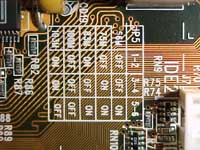Fall Comdex '98 Coverage
by Anand Lal Shimpi on November 21, 1998 11:19 AM EST- Posted in
- Trade Shows
While we all may be able to enjoy the fall weather and the gorgeous scenery this time of year provides us with, we aren't all able to fly all the way out to Las Vegas for the annual Fall Comdex Convention, luckily, if you've got access to the internet, you've also got access to AnandTech, which also means, you're in store for complete coverage of the hottest items from the show. AnandTech will be covering Comdex for the first three days of the show, starting Monday and ending Wednesday evening. For those of you that don't know, Comdex lasts from 10:30AM till around 6:30PM every day, and it attracts some of the biggest names in manufacturers and members of the media alike. It's a wonderful place to interact with the faces behind the email addresses, something we don't often get to do in our computer driven workplaces, so without further ado, let's get to Fall Comdex '98 Day 1, through the eyes of your webmaster.
Motherboards
What would Comdex '98 Coverage on AnandTech be without some motherboard coverage, well, I spent most of today interacting with a number of motherboard and chipset manufacturers present in the immediate area around The Sands convention center. Comdex itself is spread out among a number of convention centers, such as the Las Vegas Convention Center, and the Sands as mentioned before. Among those companies were ABIT, ALi, AOpen, DFI, Gigabyte, MSI, Shuttle, and VIA.
The most interesting and unique displays in the motherboard category were definitely the upcoming products making use of Intel's soon to be announced Socket-370 interface. |
 |
| As you probably have already heard, Intel realized that in order for the Celeron to truly be a low cost solution, it would have to ditch the bulky and costly PCB in favor of a socket design. However, this also meant one thing, that Intel was wrong in saying that the future lay in the arms of Slot-1 and that the future of Socket-7 was dead. In order to avoid admitting such a failure, Intel decided to create their own socket design intended to replace Socket-7 as the ideal low cost platform, thus creating Socket-370. | |
| Socket-370 based motherboards will feature the common Intel 440BX chipset, which supports the 100MHz FSB, as well as the unreleased Intel 440ZX chipset which is essentially a degraded version of the BX. The ZX will be available in 66MHz and 100MHz FSB flavors with the latter being introduced sometime late next year. |
|
One thing the market failed to remember when the Celeron was originally launched was that this was intended to be a "low cost" platform, however with the price of a Celeron system just a few hundred dollars less than the price of a Pentium II system, it is obvious that the main goal for the processor platform became diluted. Luckily, mainboard manufacturers have taken it upon themselves to produce a true successor to the Intel TX line of motherboards that were so incredibly popular, their solution? Socket-370 motherboards based on the Intel 440LX chipset. These puppies won't support the 100MHz FSB (75/83MHz settings are likely) however they'll also be able to give the current Socket-7 market a good bashing as they should sell for much less than their BX/ZX counterparts.
With the LX based Socket-370 motherboards priced at rock bottom levels, and BX based boards coming in at a much higher premium, the ZX falls in between the two in terms of pricing. Unless motherboard manufacturers outfit their ZX based Socket-370 boards with options for the 100MHz FSB setting now, the LX or BX based products will prevail over their unique ZX counterpart. You can think of the ZX chipset as the EX chipset for the BX market, if you can follow that comparison that is ;)











0 Comments
View All Comments